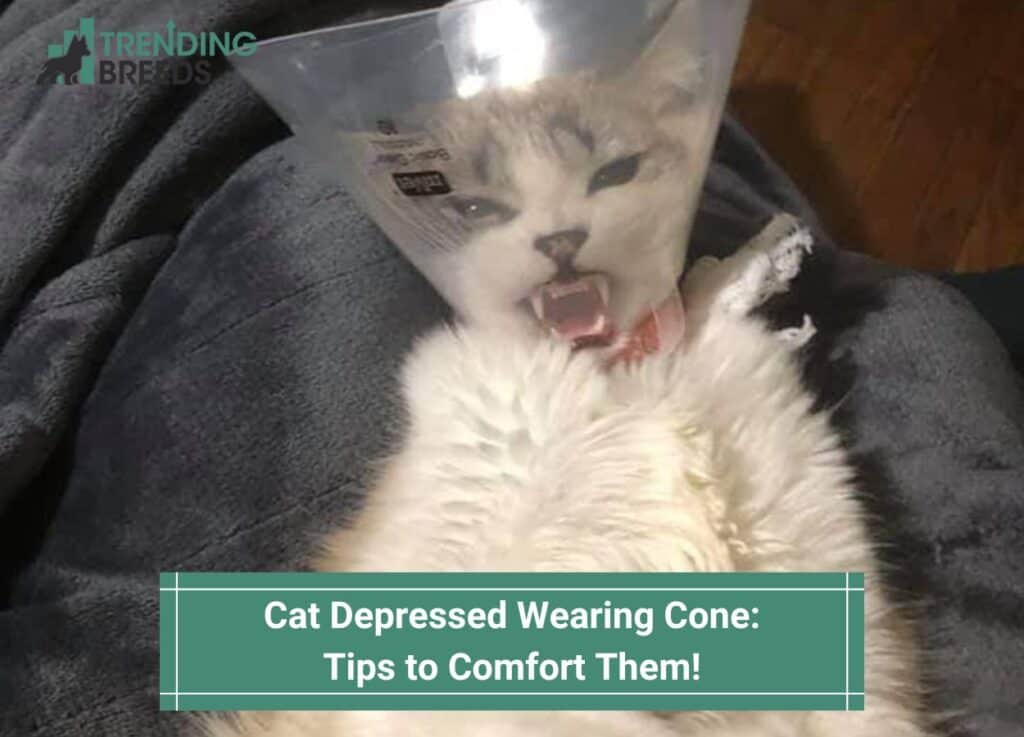
Right after surgery, cats find themselves in unfamiliar territory. Cats are creatures of habit. And any derivation from their routine can make them immediately feel uneasy.
Think about it this way: you are sick but also can’t convey your discomfort or can’t even comprehend why you have a cone on in the first place.
That is exactly how your cat feels; the physical pain combined with this sense of vulnerability can make your cat feel depressed.
And, its our job to help our feline friends feel more at home. In this article, we will go through some tips that help you comfort your cat.
Before you scroll further down this guide, check out these other cat-related articles: What Is The Lethal Dose Of Benadryl For Cats? and How to Euthanize a Cat?.
[ez-toc]How To Find Out If My Cat Is Struggling With Their Cone?
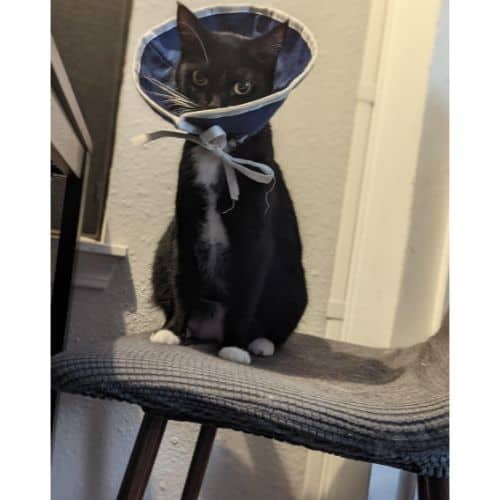
Not every cat struggles with their cone. Some (especially if they get used to it), don’t mind it as much.
However, there are some undeniable signs that your cat may be struggling with their cone and you might need to step in to help.
- Withdrawal From Social Activities: Cats have moments where they seek companionship or play. But, if you observe that your suddenly sociable cat is avoiding interaction, it is a sign they aren’t really feeling their best.
- A Change in Sleep: Cats love to sleep. But, if your cat is sleeping excessively or, on the other hand, is showing signs of insomnia, it could be a sign of stress.
- Extremely Aggressive: If your cat scratches and bites you? This change in temperament can be attributed to discomfort or distress as well.
- Trying To Take Their Cone: Obviously, this is a telltale sign that your cat is not very comfortable with their cone. If they are trying to kick it off, or even worse, hitting walls trying to get the cone to come off, your cat is not keen on keeping the cone on their feline friend.
- Poor Appearance: If your cat neglects their grooming ritual, it’s not just about looking disheveled. It can be a sign they’re feeling down or unwell.
- Vocal Distress: Constant meowing or unusual sounds uttered by a cat can indicate that they are trying to communicate with their distress.
How To Stop Your Cat From Feeling Distressed?
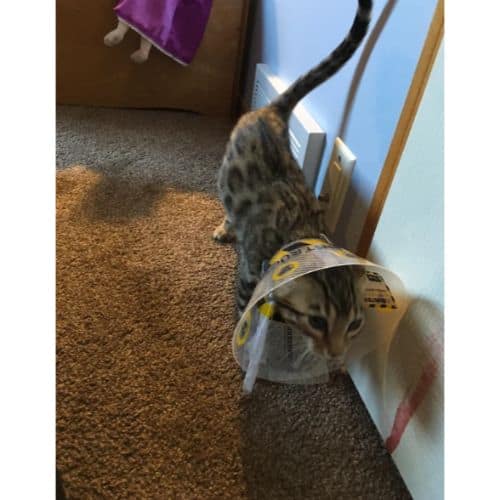
Once you have identified that your cat is starting to struggle, you should immediately start implementing strategies that help you reduce their discomfort.
While these measures are quite obvious, they can make a major difference in their upbringing.
1. Adjust Your Cone
Just as you would adjust a plaster cast if it’s causing discomfort, you should apply the same concept to the cone. Make sure that it isn’t very tight, or too loose either.
The easiest way to check is if you are able to fit two fingers between the cone itself and your cat’s neck.
A plastic cone gets rigid over time. If the cone has been consistently exposed to the elements, there’s a high chance that it gets hardened up over time.
The easiest way to identify that would be to see your cone’s color. If it is yellow, it’ll get much harder.
We recommend switching to a soft cone, which can be much more comfortable for your cat, especially when resting.
If you have a smaller cat, and it seems excessively long, you can trim it slightly.
However, make sure that it does not compromise its primary purpose in any way or form. This might make navigation much easier for your cat.
2. Provide More Vertical Spaces For Your Cat
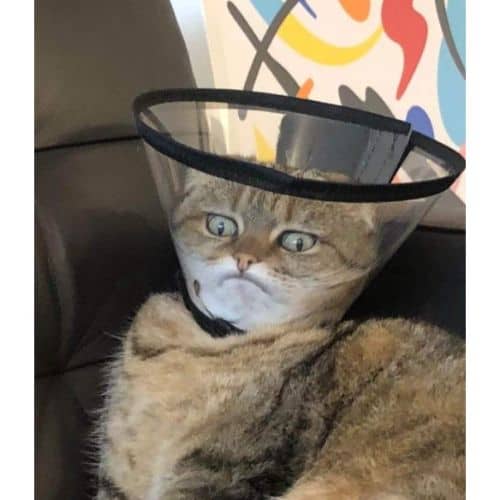
Cats instinctively seek high spaces, not just for playing but also for a sense of security.
When wearing a cone, cats will feel more vulnerable. Investing in a meticulously designed cat tree or shelf, and providing your cat with vertical spaces will help boost their confidence.
This kind of vantage point will also allow them to observe their surrounding environments without feeling threatened.
Make sure that these structures are stable and also have soft landing pads or cushions in case your cat slips since your cat has a cone.
3. Give Your Cat Cone-Free Time
Ensure your cat keeps their cone on to prevent them from injuring themselves further.
However, everyone deserves a break, especially your cat, who probably feels extremely uncomfortable and suffocated.
Therefore, consider providing short, supervised breaks without the cone.
This allows them to groom, eat, and play more comfortably. Make sure that they don’t lick their wounds during this entire time.
There’s a high chance that they’ll immediately try and hide away from you and start licking their wounds.
Naturally, a cat’s tongue isn’t meant to lick their wounds due to its prickly nature.
And, if they do end up licking their wound excessively, it destroys the purpose of your cat wearing the cone in the first place.
4. Enhance Your Cat’s Diet and Hydration
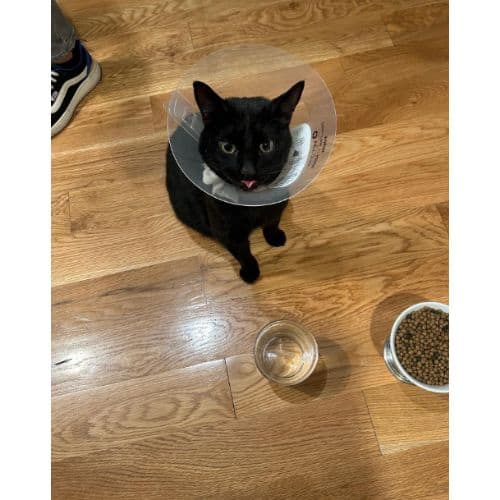
Your cat’s mood directly impacts your overall mood and health. When your cat is recovering, your cat may benefit from a diet that is more tailored to their needs.
If they are stressed, we recommend switching to grain-free cat food that is rich in protein and does not have any harmful additives as well.
Introducing them to wet food can boost their hydration as well, an important element during recovery.
You can get a nicely designed water fountain, simulating running water, which cats generally are more drawn to.
You should monitor their eating habits closely since a sudden decrease in appetite can indicate stress. Cats tend to be very cognizant of their diet and hydration.
Generally, you don’t need to care about their punctuality regarding eating and drinking.
But, when they are sick, you will have to be very careful about what kind of food they are eating and when they are eating and drinking it as well.
5. Start Implementing Grooming Sessions
Since your cat is wearing a cone, cats can’t groom themselves.
This leads to feelings of helplessness in cats. If you offer to step in and assist, it can be quite therapeutic for you and your cat as well.
Do not start off by trying to comb them aggressively. Instead, get an extremely soft grooming brush and start from there.
These sessions will help your cat feel more clean, uplifting their mood.
Moreover, brushing your cat simulates affection, something they may be missing. This will strengthen the bond with your cat even further.
6. Start Monitoring Their Environment
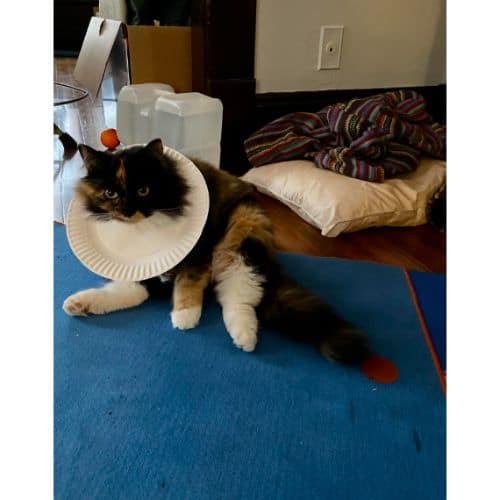
A small change in your cat’s environment can lead to much stress for a cat that still has a cone on.
You should never try and suddenly change your cat’s environment.
Make sure that their living space is consistent and is also free from any sudden changes as well.
We recommend creating a safe space or a sanctuary room as well.
This is supposed to be a cozy spot that is filled with their favorite toys, scents, bedding, and other items that they are fond of.
This will also be an escape from the busier parts of the household.
Moreover, if you have other pets or young children in the house, your cat might start feeling overwhelmed with the cone on.
In those cases, dedicate a room or corner as their safe zone by using gates or barriers. This allows them further peace away from any potential chaos as well.
7. Ensure Safe Playtime
While your cat does have a cone, their movement and perception can also be quite restricted.
But playtime is extremely important for a cat and should never be eliminated, even if they have a cone.
You should opt for toys that are safe and ones that won’t require a lot of chasing or precision, like plush toys or extremely slow-moving automated toys.
This will keep them engaged without even risking their injury in any way or form.
8. Don’t Forget To Love Your Cat
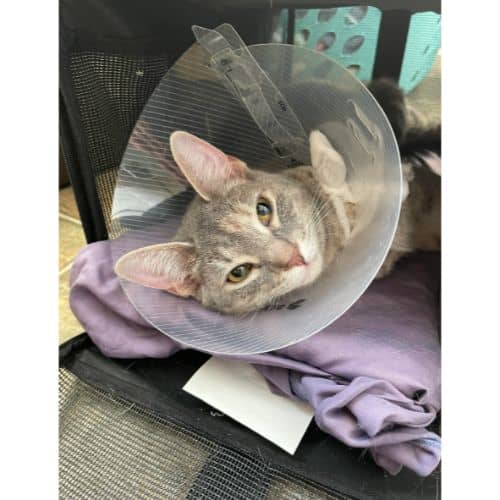
Reward and praise your cat when they behave calmly. Start using treats, soft words, and gentle petting.
This will help reinforce the idea that staying calm with the cone on isn’t all that bad of an idea.
If your cat needs to have the cone on for a long time, this positive association can help reduce their overall distress.
Continuity is extremely calming for your cat. Try to keep your cat’s daily routine unchanged as much as possible.
Go for regular feeding times, have the same resting spots, and even keep the timing or play sessions even similar.
These provide a sense of normalcy in an unsettling period.
During these gentle petting and patting sessions, regularly check your cat for signs of infections, excessive swelling, or any discharge.
If you do notice anything unusual, it is crucial to consult your vet promptly.
Cat Depressed Wearing Cone: Tips to Comfort Them
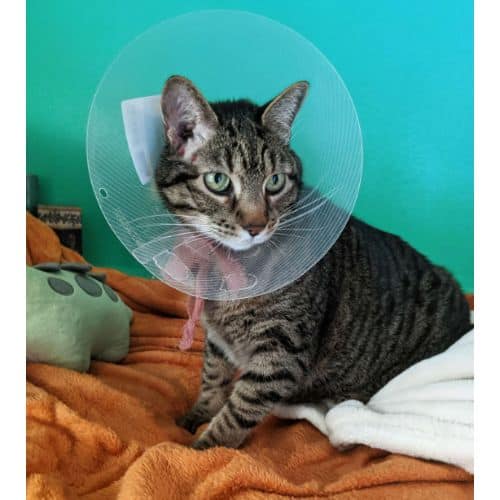
Navigating the post-surgical period with your cat can be quite a challenge.
The site of your cat hindered by a cone they don’t understand or appreciate can make you feel quite horrendous.
But it serves a purpose in ensuring their swift and safe recovery.
Understanding their signs of distress and then consequently taking the right action can make a world of difference.
The cone is temporary in the end, and it’ll go away soon.
However, the cove, care and understanding that you provide to your cat during this time will leave a big mark on the bond that you have with your cat.
If you find this guide, “Cat Depressed Wearing Cone: Tips to Comfort Them,” informative and helpful, you can check out these other cat-related articles from our team:
- When to Euthanize a Cat with Feline Leukemia?
- Can a Bug Zapper Kill a Cat?
- Why are My Cat’s Whiskers Curly?
You can learn more about this topic by watching “How to Tell if a Cat Is Depressed” down below:




